Shimaa Naser
Towards Zero Touch Networks: Cross-Layer Automated Security Solutions for 6G Wireless Networks
Feb 28, 2025



Abstract:The transition from 5G to 6G mobile networks necessitates network automation to meet the escalating demands for high data rates, ultra-low latency, and integrated technology. Recently, Zero-Touch Networks (ZTNs), driven by Artificial Intelligence (AI) and Machine Learning (ML), are designed to automate the entire lifecycle of network operations with minimal human intervention, presenting a promising solution for enhancing automation in 5G/6G networks. However, the implementation of ZTNs brings forth the need for autonomous and robust cybersecurity solutions, as ZTNs rely heavily on automation. AI/ML algorithms are widely used to develop cybersecurity mechanisms, but require substantial specialized expertise and encounter model drift issues, posing significant challenges in developing autonomous cybersecurity measures. Therefore, this paper proposes an automated security framework targeting Physical Layer Authentication (PLA) and Cross-Layer Intrusion Detection Systems (CLIDS) to address security concerns at multiple Internet protocol layers. The proposed framework employs drift-adaptive online learning techniques and a novel enhanced Successive Halving (SH)-based Automated ML (AutoML) method to automatically generate optimized ML models for dynamic networking environments. Experimental results illustrate that the proposed framework achieves high performance on the public Radio Frequency (RF) fingerprinting and the Canadian Institute for CICIDS2017 datasets, showcasing its effectiveness in addressing PLA and CLIDS tasks within dynamic and complex networking environments. Furthermore, the paper explores open challenges and research directions in the 5G/6G cybersecurity domain. This framework represents a significant advancement towards fully autonomous and secure 6G networks, paving the way for future innovations in network automation and cybersecurity.
Large Language Model-Driven Curriculum Design for Mobile Networks
May 28, 2024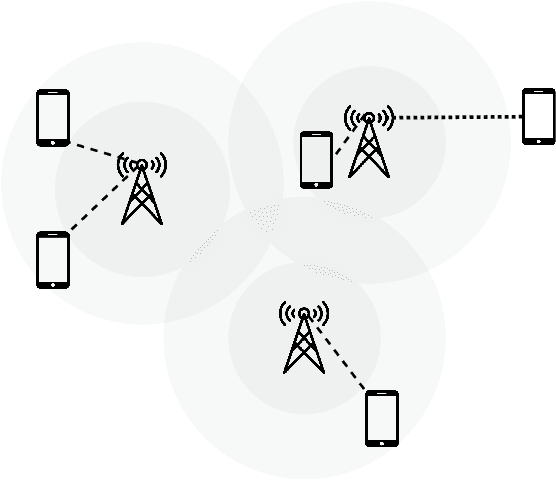
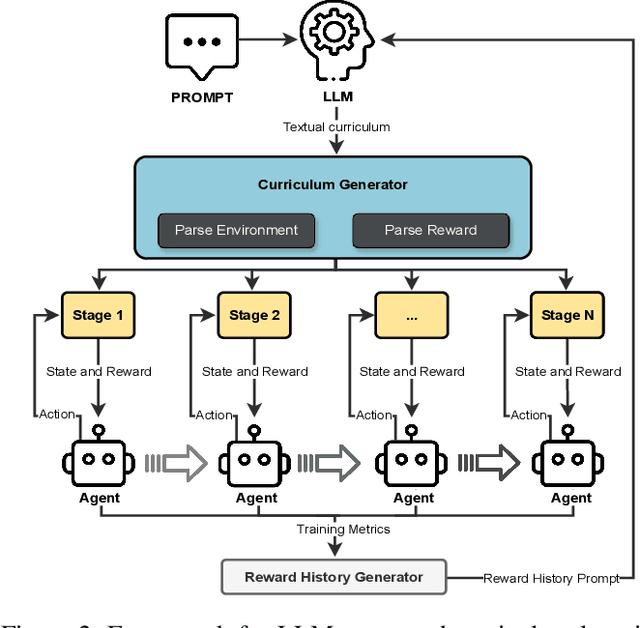
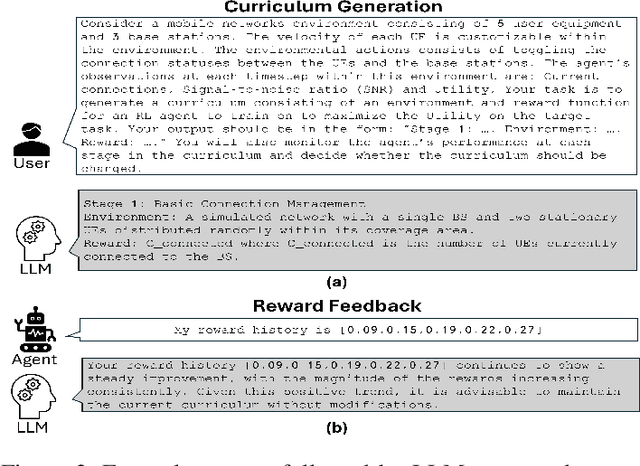
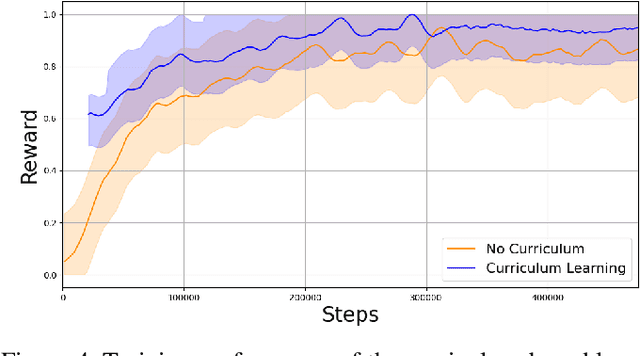
Abstract:This paper proposes a novel framework that leverages large language models (LLMs) to automate curriculum design, thereby enhancing the application of reinforcement learning (RL) in mobile networks. As mobile networks evolve towards the 6G era, managing their increasing complexity and dynamic nature poses significant challenges. Conventional RL approaches often suffer from slow convergence and poor generalization due to conflicting objectives and the large state and action spaces associated with mobile networks. To address these shortcomings, we introduce curriculum learning, a method that systematically exposes the RL agent to progressively challenging tasks, improving convergence and generalization. However, curriculum design typically requires extensive domain knowledge and manual human effort. Our framework mitigates this by utilizing the generative capabilities of LLMs to automate the curriculum design process, significantly reducing human effort while improving the RL agent's convergence and performance. We deploy our approach within a simulated mobile network environment and demonstrate improved RL convergence rates, generalization to unseen scenarios, and overall performance enhancements. As a case study, we consider autonomous coordination and user association in mobile networks. Our obtained results highlight the potential of combining LLM-based curriculum generation with RL for managing next-generation wireless networks, marking a significant step towards fully autonomous network operations.
Defeating Proactive Jammers Using Deep Reinforcement Learning for Resource-Constrained IoT Networks
Jul 13, 2023Abstract:Traditional anti-jamming techniques like spread spectrum, adaptive power/rate control, and cognitive radio, have demonstrated effectiveness in mitigating jamming attacks. However, their robustness against the growing complexity of internet-of-thing (IoT) networks and diverse jamming attacks is still limited. To address these challenges, machine learning (ML)-based techniques have emerged as promising solutions. By offering adaptive and intelligent anti-jamming capabilities, ML-based approaches can effectively adapt to dynamic attack scenarios and overcome the limitations of traditional methods. In this paper, we propose a deep reinforcement learning (DRL)-based approach that utilizes state input from realistic wireless network interface cards. We train five different variants of deep Q-network (DQN) agents to mitigate the effects of jamming with the aim of identifying the most sample-efficient, lightweight, robust, and least complex agent that is tailored for power-constrained devices. The simulation results demonstrate the effectiveness of the proposed DRL-based anti-jamming approach against proactive jammers, regardless of their jamming strategy which eliminates the need for a pattern recognition or jamming strategy detection step. Our findings present a promising solution for securing IoT networks against jamming attacks and highlights substantial opportunities for continued investigation and advancement within this field.
An Effective Spatial Modulation Based Scheme for Indoor VLC Systems
Jan 19, 2022Abstract:We propose an enhanced spatial modulation (SM)-based scheme for indoor visible light communication systems. This scheme enhances the achievable throughput of conventional SM schemes by transmitting higher order complex modulation symbol, which is decomposed into three different parts. These parts carry the amplitude, phase, and quadrant components of the complex symbol, which are then represented by unipolar pulse amplitude modulation (PAM) symbols. Superposition coding is exploited to allocate a fraction of the total power to each part before they are all multiplexed and transmitted simultaneously, exploiting the entire available bandwidth. At the receiver, a two-step decoding process is proposed to decode the active light emitting diode index before the complex symbol is retrieved. It is shown that at higher spectral efficiency values, the proposed modulation scheme outperforms conventional SM schemes with PAM symbols in terms of average symbol error rate (ASER), and hence, enhancing the system throughput. Furthermore, since the performance of the proposed modulation scheme is sensitive to the power allocation factors, we formulated an ASER optimization problem and propose a sub-optimal solution using successive convex programming (SCP). Notably, the proposed algorithm converges after only few iterations, whilst the performance with the optimized power allocation coefficients outperforms both random and fixed power allocation.
Space-Time Block Coded Spatial Modulation for Indoor Visible Light Communications
Nov 06, 2021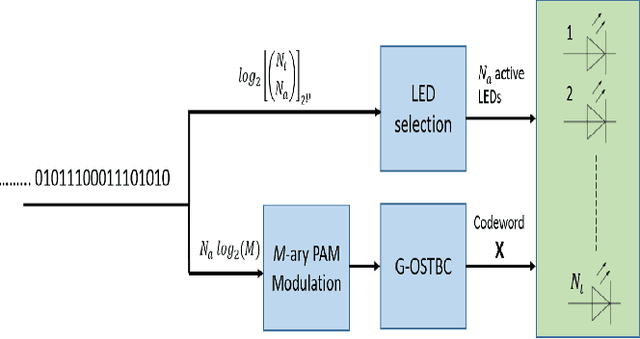
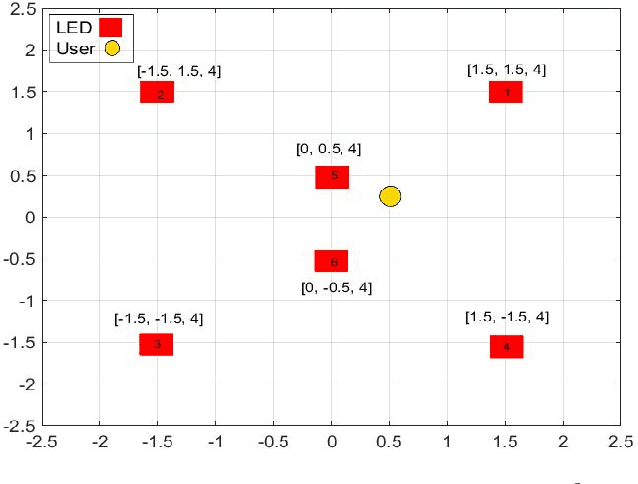
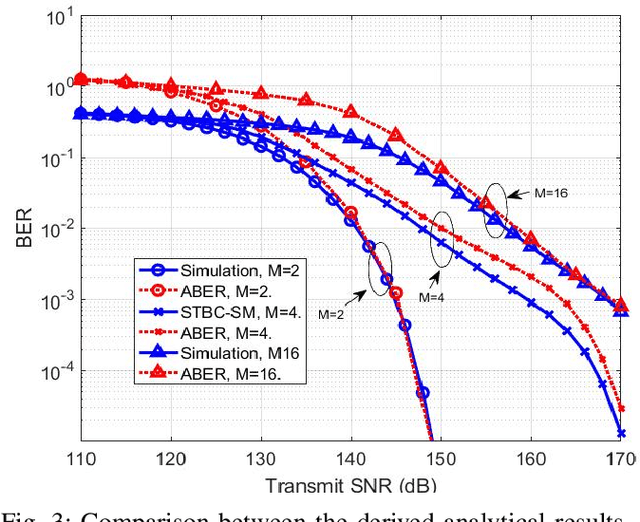
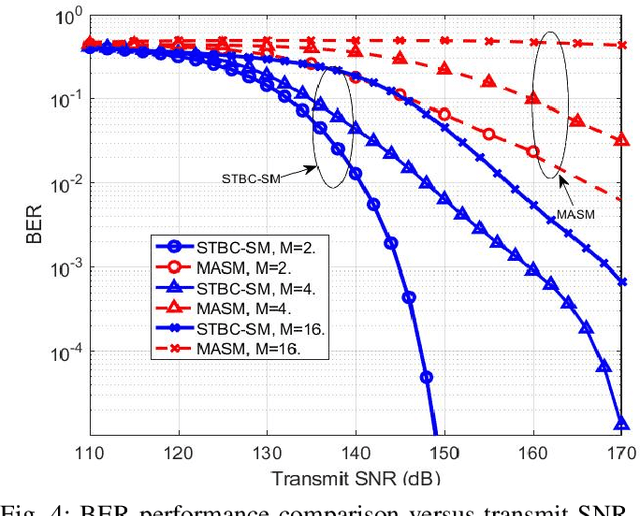
Abstract:Visible light communication (VLC) has been recognized as a promising technology for handling the continuously increasing quality of service and connectivity requirements in modern wireless communications, particularly in indoor scenarios. In this context, the present work considers the integration of two distinct modulation schemes, namely spatial modulation (SM) with space time block codes (STBCs), aiming at improving the overall VLC system reliability. Based on this and in order to further enhance the achievable transmission data rate, we integrate quasi-orthogonal STBC (QOSTBC) with SM, since relaxing the orthogonality condition of OSTBC ultimately provides a higher coding rate. Then, we generalize the developed results to any number of active light-emitting diodes (LEDs) and any M-ary pulse amplitude modulation size. Furthermore, we derive a tight and tractable upper bound for the corresponding bit error rate (BER) by considering a simple two-step decoding procedure to detect the indices of the transmitting LEDs and then decode the signal domain symbols. Notably, the obtained results demonstrate that QOSTBC with SM enhances the achievable BER compared to SM with repetition coding (RC-SM). Finally, we compare STBC-SM with both multiple active SM (MASM) and RC-SM in terms of the achievable BER and overall data rate, which further justifies the usefulness of the proposed scheme.
Towards Federated Learning-Enabled Visible Light Communication in 6G Systems
Oct 07, 2021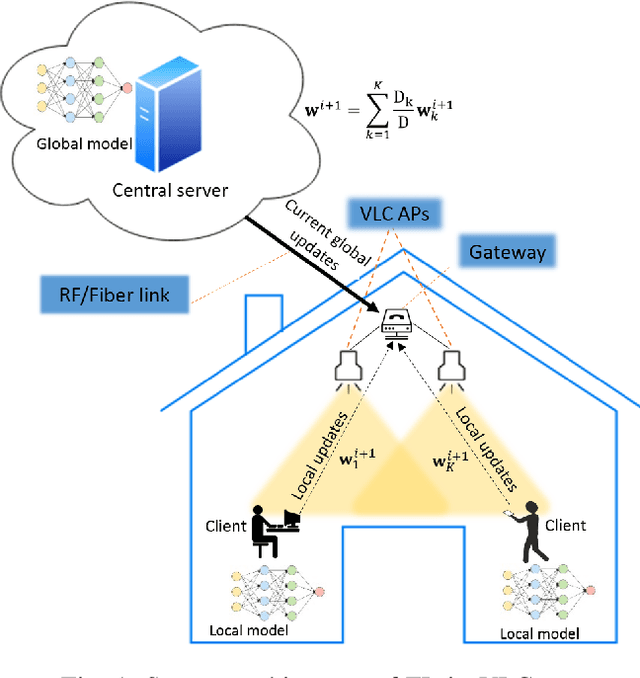
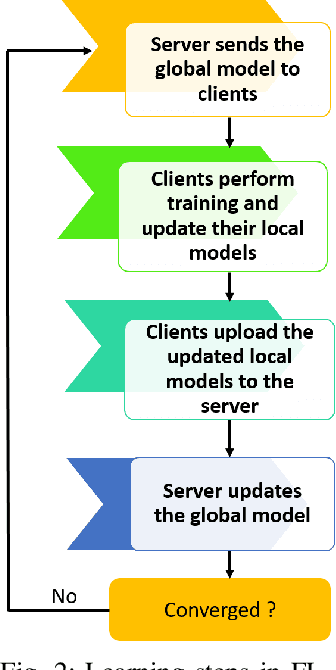
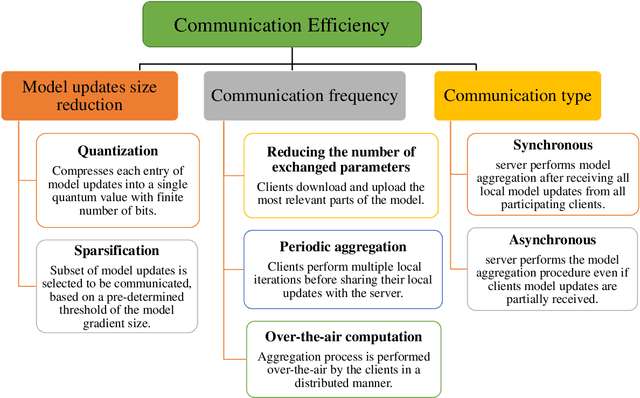
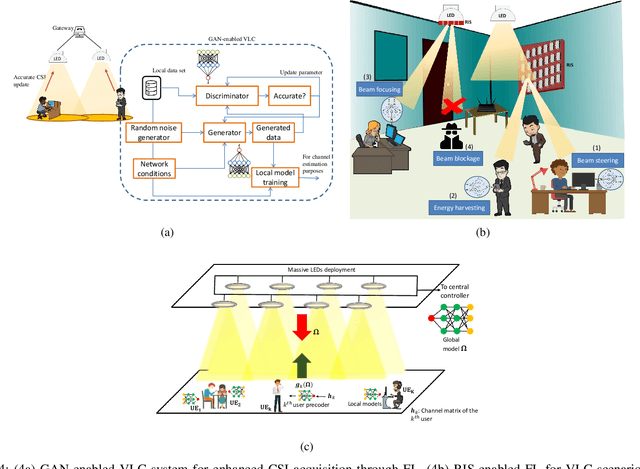
Abstract:Visible light communication (VLC) technology was introduced as a key enabler for the next generation of wireless networks, mainly thanks to its simple and low-cost implementation. However, several challenges prohibit the realization of the full potentials of VLC, namely, limited modulation bandwidth, ambient light interference, optical diffuse reflection effects, devices non-linearity, and random receiver orientation. On the contrary, centralized machine learning (ML) techniques have demonstrated a significant potential in handling different challenges relating to wireless communication systems. Specifically, it was shown that ML algorithms exhibit superior capabilities in handling complicated network tasks, such as channel equalization, estimation and modeling, resources allocation, and opportunistic spectrum access control, to name a few. Nevertheless, concerns pertaining to privacy and communication overhead when sharing raw data of the involved clients with a server constitute major bottlenecks in the implementation of centralized ML techniques. This has motivated the emergence of a new distributed ML paradigm, namely federated learning (FL), which can reduce the cost associated with transferring raw data, and preserve privacy by training ML models locally and collaboratively at the clients' side. Hence, it becomes evident that integrating FL into VLC networks can provide ubiquitous and reliable implementation of VLC systems. With this motivation, this is the first in-depth review in the literature on the application of FL in VLC networks. To that end, besides the different architectures and related characteristics of FL, we provide a thorough overview on the main design aspects of FL based VLC systems. Finally, we also highlight some potential future research directions of FL that are envisioned to substantially enhance the performance and robustness of VLC systems.
 Add to Chrome
Add to Chrome Add to Firefox
Add to Firefox Add to Edge
Add to Edge